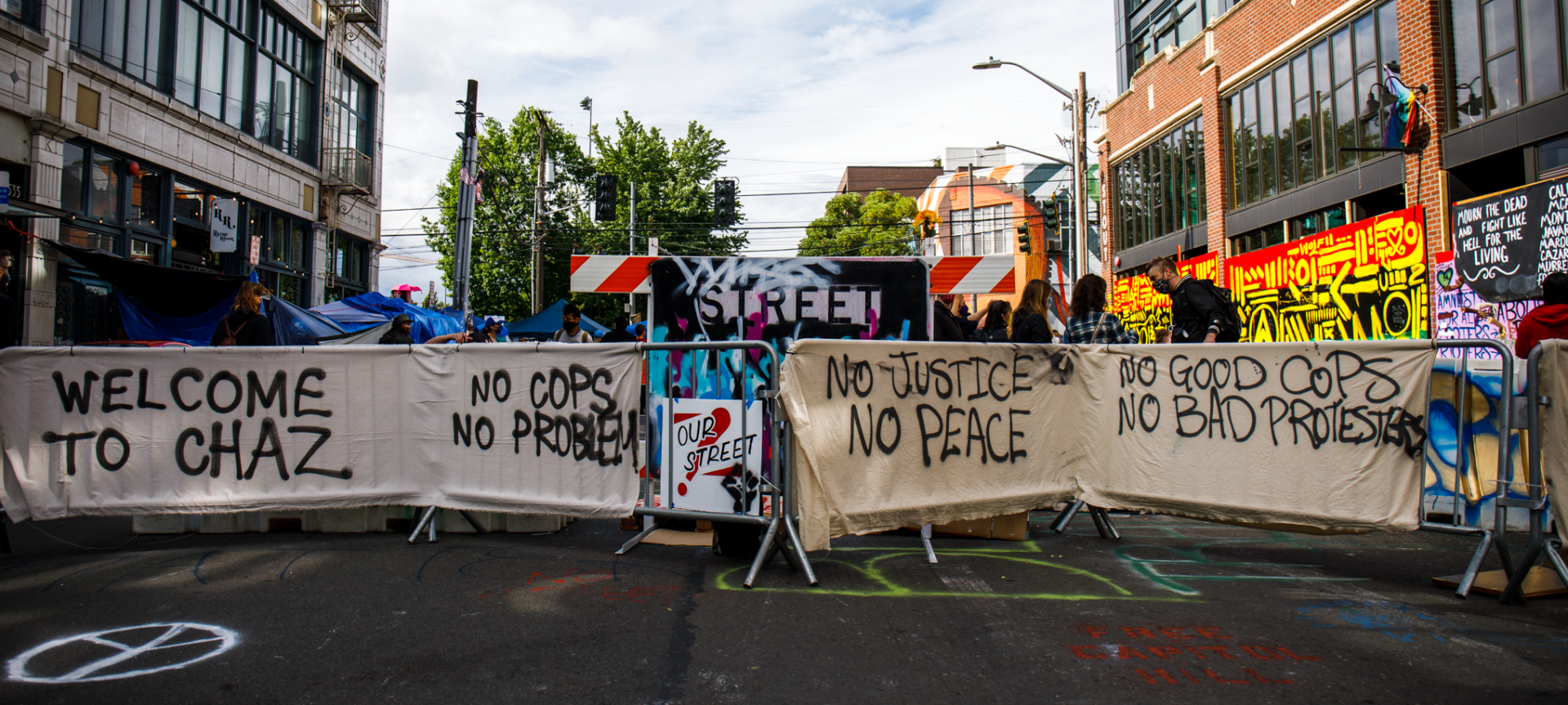Black Lives Matter street mural in the CHAZ. Photo: Kyle Kotajarvi / Wikipedia Commons
Life and times at the Capitol Hill Autonomous Zone
- June 16, 2020
Anarchism & Autonomy
Following a long tradition of left revolutionary praxis, protesters in Seattle have declared a cop-free autonomous zone in the heart of the city.
- Author
Over the past few weeks we have witnessed one of the largest uprisings in recent US history. The police killing of George Floyd in Minneapolis, Minnesota, brought millions of people in the US and around the world out into the streets in aggressive demonstrations. In cities across the country, police precincts were set on fire, corporate stores looted, and as the police turned their sights on the protests, the numbers only grew.
In Seattle, Washington, confrontations with protesters in a gentrified part of the city known as Capitol Hill led to law enforcement’s retreat from their office. Organizers and community members advanced on the area and transformed this eight-block segment of the neighborhood into a collective space, which they soon called the Capitol Hill Autonomous Zone (CHAZ).
The CHAZ has become the focus of right-wing rage, from the media to the president, as they intimate that this is a terrorist operation controlled by brutal anarchist cells. Photos, videos, testimonies from the inside the CHAZ paint a very different picture, communicating something closer to other occupations (Occupy movement?) where people moved from simple protests to experimenting in living differently.
Hundreds of people are putting in the labor to keep things like a medical clinic, a café, concerts and speakers, a community garden, and other resources into a stable infrastructure of mutual aid. They have done so with the support of local organizations and even businesses. Now the CHAZ is hitting a point where they are building for the future, discussing differences in direction and priorities, and how they are going to navigate the negotiation between immediate reforms and more revolutionary aims.
I spoke with two organizers of the CHAZ about what drew them there, how it has been working, and where they hope to go with the project. Both are using pseudonyms, one going by Officer CHAZ (OCHAZ) and the other going by Frank Ascaso (FA), who also organizes with the Black Rose / Rosa Negra Anarchist Federation. These organizers were interviewed separately from one another and were combined here into one conversation.
We’re in one of the largest rebellions in the last fifty years. How did you get involved in the demonstrations and the autonomous project that became the CHAZ?
OCHAZ: It’s been a long road to the breaking point. George Floyd and Breonna Taylor’s deaths really pushed us over the edge this time. I knew I could no longer live with myself if I remained silent and complacent. I became infused with a burning desire to take action, so I rushed to the front lines of the protest marches in Seattle at the earliest opportunity. It was the least I could do, but quite literally a step in the right direction. Everybody’s got a unique story to tell about their journey to Capitol Hill Autonomous Zone (CHAZ), but for me, it was the ecstasy of finally taking a firm stand against systemic oppression. That feeling became such an intense high, that I never wanted to come down. I am addicted to justice, and it’s one drug that I will never give up.FA: Networks of activists and organizers here in Seattle had been having discussions as Minneapolis and other cities had ignited in protests and riots. There’s a long history of anti-police organizing here with movements to block the expansion of a youth detention center and a so-called “police bunker,” an expansion to a police facility in the northern part of the city. So in those networks people started talking about what we could do here in solidarity with Minneapolis. So people started planning protests for that weekend. And a whole bunch of various groups, from anarchists to church and pacifist groups to the anti-police coalitions, started planning their own thing. The first weekend of protest there were a half dozen different calls to action, and that’s when the riots started here as well. So that’s when I showed up, in those early days.
How does the CHAZ coordinate with the rest of the city’s protest movement?
FA: I would say they are a piece of it, but I would not call it the center [of the movement]. This moment around Black lives is incredible and every group is taking pretty dramatic action. And I would say that is continuing. There are non-profit groups leading marches, there are church groups leading marches, there’s the anti-prison and abolition groups leading marches, and a lot of those are happening outside the space. They were happening before and they were using their own infrastructure and resources to make them happen, and that is still happening.

The abandoned Seattle Police East Precinct inside CHAZ. Photo by Derek Simeone / Flickr
For example, there was recently a march of 60,000 people between two of the largest parks in Seattle, which, from what I could tell, had little connection to the CHAZ. There was also a children’s march, which seemed to have little connection to the CHAZ. That said, there are things being planned in the autonomous space. So, for example, last night (June 14) I participated in a protest that marched out of the autonomous zone, a Black Lives Matter march, to challenge the police and occupy streets elsewhere. People are planning things from the autonomous space too, but this moment is so dramatic and diverse that lots of things are happening outside of it too.
What was the process by which the zone was first opened up and established? What were the protests like before its formation?
OCHAZ: As with any social movement, it’s difficult to pinpoint an exact origin. The events leading up to the formation of CHAZ have been so surreal and chaotic at times that I’m not sure whether I’ll ever fully understand what happened to get us here. But I want it to be clear that the “Regime” [CHAZ-lingo for the Seattle Police Department] struck first. They’ve been killing us for decades. For as long as we can remember, the people of Capitol Hill have begged the City Council to clean up their mess, but they never listen. They’re too busy sucking Jeff Bezos’s dick to even glance at us. Our so-called political “leaders” will never miss a wink of sleep over the dead bodies of marginalized folks piling up in the streets, so now we’re going to give them something to really lose sleep over.
But even when we protested “the right way,” by peacefully marching, did they listen then? No. They sent their Seattle Police Department (SPD) goon squad after us, treated us like we were criminals—worse than criminals, because at least criminals get a trial. We were more like animals to them. During the march, I watched as dozens of my comrades were brutalized by riot police, simply for demanding reform and racial equity. We tried safe civil disobedience, but the “good ol’ boys” at the SPD never let us down when it comes to the level of violence we’ve come to expect from them.
FA: There had been a week and a half of steady confrontations in that space. Every day from maybe six or seven o’clock in the evening to midnight or one in the morning, pretty regular confrontations. People were pretty exhausted, actually, by the time the police withdrew from that space. Definitely, lots of people showed up that night, but a lot of folks went home early. So when the declaration of the autonomous zone came out after midnight, a lot of people were not there for the evening — I wasn’t there either.
How did the crowd take the space?
OCHAZ: There wasn’t any particular tactic or method, we just… took it. It was ours anyway, as far as we were concerned. Putting up those barriers just felt like the most natural thing we could ever do to protect ourselves. When shit hit the fan at the protest, we switched to auto-pilot, no thought required, just the pure energy of the crowd directing our concentrated motion. We moved as a unit, as if we all shared the same body and mind in the heat of that moment.
The last thing I remember was facing off against the cops down on Pine Street. Recalling the black bloc tactic, we used our bodies to create a wall, but I never expected one of them to run around and sucker-punch my good pal, Dikembe, who was standing off to the side. “Big D” wasn’t even part of our bloc, just an innocent bystander, and that was the last straw for me. I snapped. I knew the bloc needed me, but D was in trouble. I couldn’t desert him even if it meant putting my own safety at risk. I basically blacked out in rage at that point, and when I came to, I was waking up in CHAZ.
All I know is that our group had rushed the line and eventually took the East Precinct. The cops got pushed back, and our barriers went up. My boy Dikembe was injured pretty bad, but that didn’t stop him from spraying the first of many tags at the border crossing in bright bold letters for the whole world to see: “CHAZ.” To the cops, that tag was a threat to back off. To us, it meant freedom.
FA: That whole day was so weird. There had been clashes with the police every night. The mayor promised not to use tear gas, but the very next night the police used tear gas anyway. The day after that, someone got shot, and the following day the police withdrew. They made this dramatic announcement in the afternoon with the police chief saying they were going to withdraw from the East Precinct.
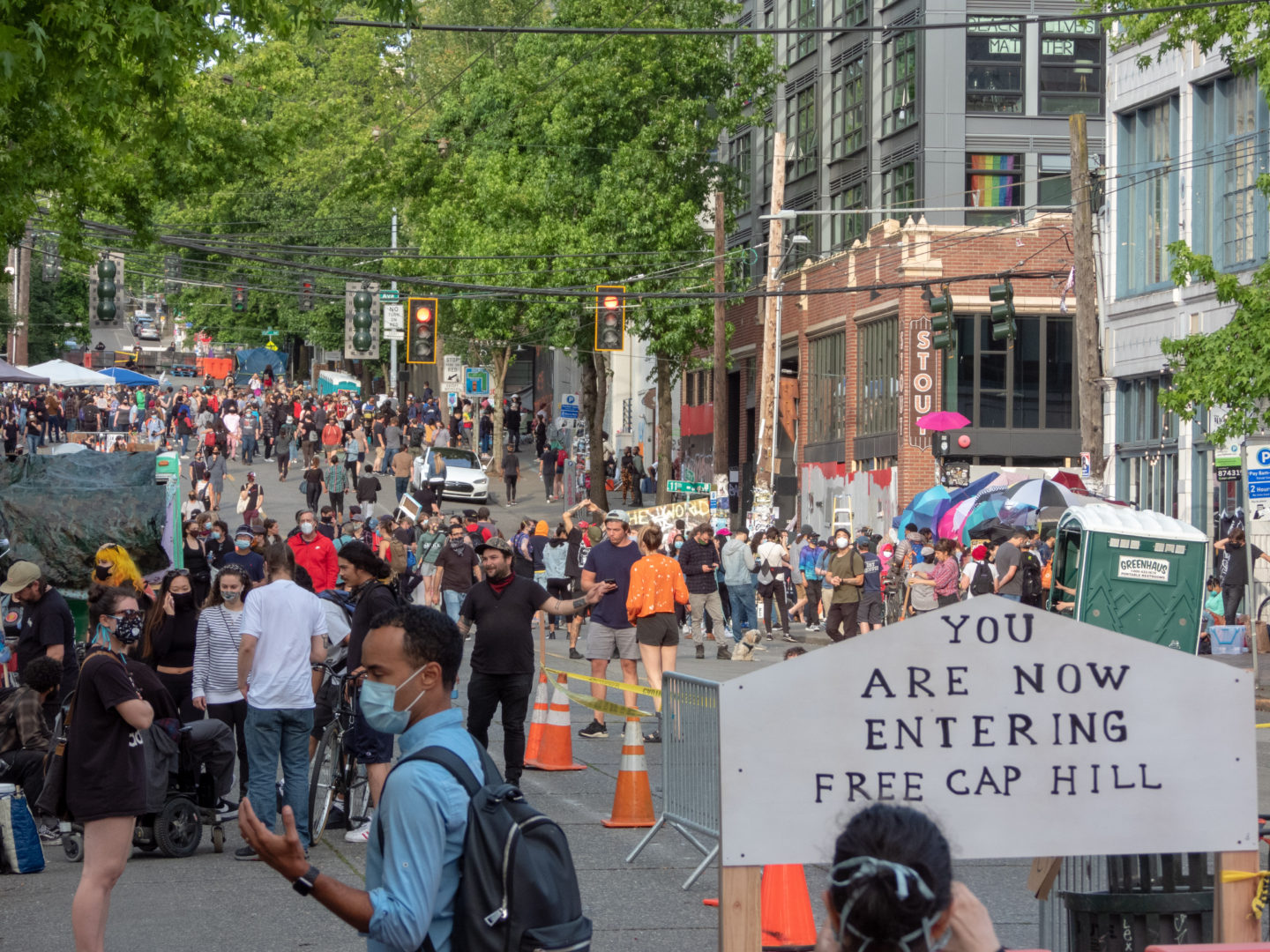
Street scene in the CHAZ, with a sign referencing the “Free Derry” autonomous zone in Derry, Northern Ireland. Photo by Alex Glidewell / Wikimedia Commons
I think there was a lot of anxiety and confusion about what to do. There was some kind of speculation that the police were withdrawing as a set-up to have people attack the precinct and break windows or burn it down so the police would have an excuse to say how bad the protesters were. This was a rumor. That evening when people got to the space, they got right up to the building and there was hesitation about doing anything. People weren’t sure, “what should we do? Do we attack it? Do we just keep the protest in the space?” And those conversations were going on throughout that day and into the night.
Then there were rumors that Proud Boys were in the area, also totally unconfirmed and probably untrue. So then people were thinking about maybe defending the space. What if other fascists come to attack the space? And my understanding is that out of those conversations came to declare an autonomous zone.
What is the idea behind the CHAZ? What is an “autonomous zone?”
FA: Autonomous zones have a long history, likely going back to the Paris Commune in which the French government refused to defend the city against a Prussian siege, a foreign siege. The people of Paris just kind of took over the mechanisms of the city and thought “we can run this better in our own interests. It turns out we don’t need you protecting us, we can take care of ourselves perfectly fine.” And they sort of restructured the city on a radically new democratic principle, a much more directly democratic form of organization.
And since then there have been a whole series of similar popular democratic actions to reclaim space and infrastructure. To run it in the interests of people instead of the police, business or military. So I see this as part of that tradition and a part of that lineage. And one of the things that is most beautiful about this space is that it is such a clear message in this moment when police can literally not stop killing people in the streets.
This past weekend there was just another Black person killed by the police in Atlanta. The autonomous zone is saying “Hey, it turns out we actually don’t need you. We can run our neighborhoods safely without policing. We can run them in much more humane interests without policing.” That political message is pretty clear and pretty strong out of this particular occupation.
OCHAZ: CHAZ is living proof that a world without police is possible. When we say, “Defund the police,” we mean exactly what that sounds like. Cops only create more problems than they try to solve. Especially for undocumented immigrants, BIPOC, WOC, trans, queer and other marginalized communities who simply do not have the privilege of being protected when they call the police for help (or when the police are called on them by some tone-deaf “Karen,” you know the type).
For us marginalized folks, any minor interaction with the police can be a death sentence. CHAZ is the antidote to all that. Our emphasis on restoration over retribution is a major part of the guiding ethos and driving force behind CHAZ. “Autonomous” to us means autonomy from the SPD’s boot on our collective neck. We don’t need the police, because we look out for each other instead. Call it what you want: a collective, a cooperative, a commune. Above of all, CHAZ is a family.
What is day-to-day life like there right now? Is it just a protest space, or are you rebuilding everyday community structures?
FA: It’s pretty interesting because the first day after the autonomous zone was declared there was almost no infrastructure in place yet. I think the call surprised a lot of people. In the next couple of days, hundreds of people came to start and set those up. Now the space feels like a sort of city within the city. It’s got a medical station. It’s got a pretty sophisticated and abundant food distribution. It has community check-ins around disputes and disturbances. It’s got a discussion space; a café space called “the decolonial café.” A community garden, informational tents, and informational sessions with free literature, nightly film screenings and a band stand with nightly performances from different bands.
So there is a ton of activity going on there, and the space itself feels very vibrant and exciting. It does feel like a festival of resistance. And people can plug into movement spaces and have organizing conversations and plan the next action. Or they can think about how to design the garden and the purpose of a community garden, things like that. To me it’s pretty incredible.
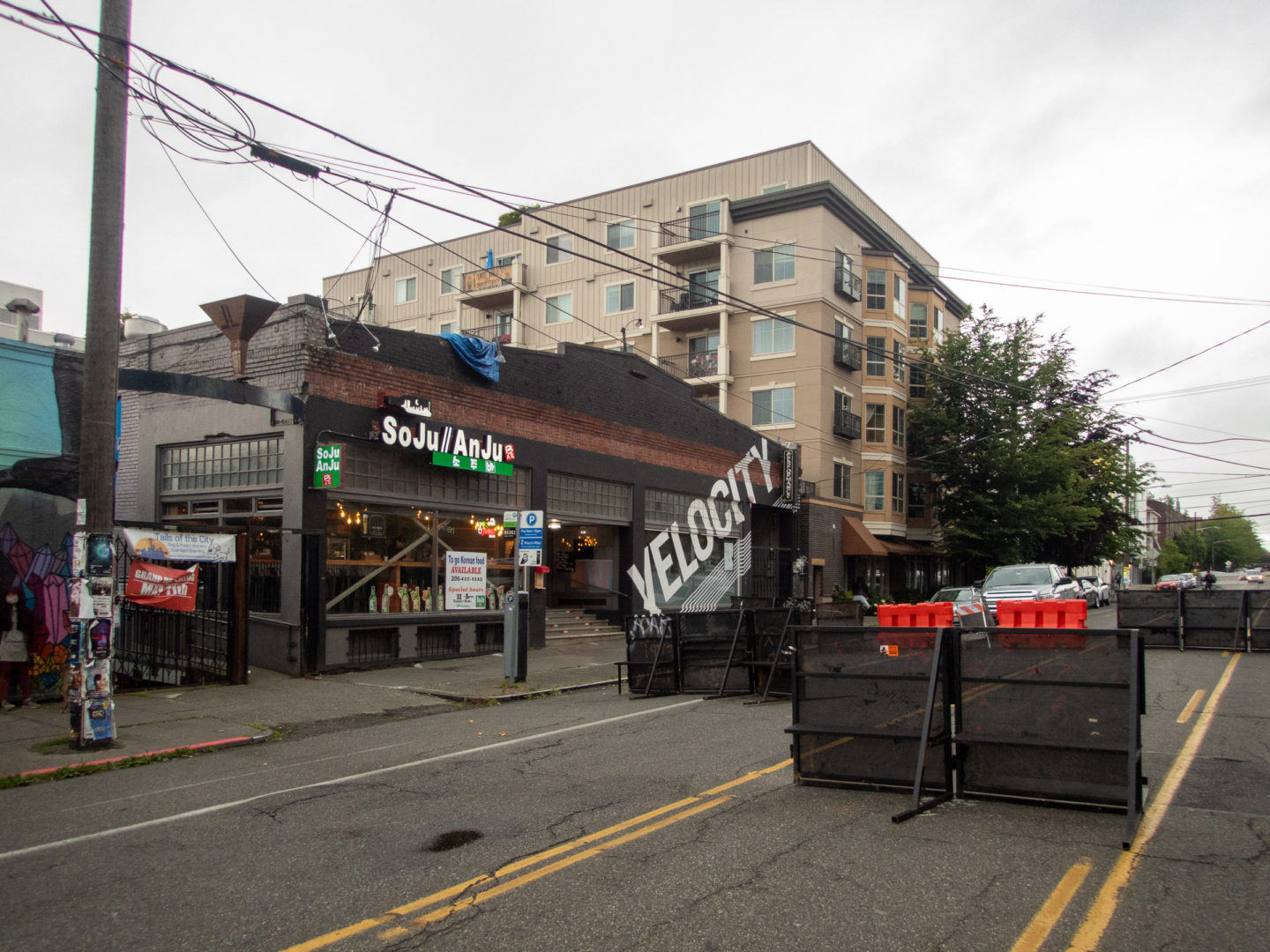
Street scene with barricades and a restaurant open for business on the edge of the CHAZ. Photo by Eldan Goldenberg / Flickr
In the first few days there was no structure, by the end of the first week people initiated a general assembly model in the middle of the afternoon. The first one was more like a “speak-out,” people talking about their experiences and processing a lot of stuff. A lot of trauma from the police violence of the previous weeks. Black voices were highlighted in their day-to-day struggles with the police. After that the general assembly turned into a “working group” model with report-backs, breaking away to work on things like logistics and then coming back to the space.
I don’t know if they have been able to make any collective decisions and I don’t know if they really have a process for that, whether it is voting, majority voting, or consensus. But it is definitely a space for the whole zone to talk to each other.
OCHAZ: Well it’s certainly nothing like the way it’s portrayed on right-wing propaganda channels like Fox News. We don’t have guarded “checkpoints,” or any of that rubbish. Our borders are open to anyone who stands in solidarity with Black lives, and anyone who seeks safety and refuge from police harassment. Some people drive into CHAZ from out of state to lend a helping hand, while others live and work completely within the boundary. Everyone who comes here with an open mind sees a flourishing environment filled with boundless love.
It feels like walking through a lucid dream 24 hours a day. We use the park to host recreational activities, such as free movie nights, stand-up comedy shows and dance parties. We have local farmers growing crops, artists painting murals to raise social awareness and wholesome activities for kids and families. There are friendly faces everywhere, like our resident 63-year-old street musician, “Papa Jacoby,” who teaches authentic West African djembe music with a focus on cultural sensitivity.
Everybody is having a lot of fun in CHAZ, but we also can’t forget why we are here and who we are fighting for. That’s why we make sure to hold regular classes on the history of racism, strategies for decolonization and the destructive legacy of whiteness. We’re working hard to unlearn systems of racism, and create a place in CHAZ where for once in the history of America, white folks take a back seat to make room for the unheard voices of Black, Brown, and Indigenous Peoples.
Everywhere you look in CHAZ, you will find a vibrant, thriving community where every citizen understands that Black Lives Matter, and they mean it with all their hearts. I’ve never seen something so beautiful that it actually makes me cry, but that pretty much sums up CHAZ for you.
How are mutual aid projects supporting the Zone to continue?
OCHAZ: Robust mutual aid programs are key to CHAZ’s success, as well as harm reduction methodologies wherever possible. The people organize themselves around community needs. Our “No-cop co-op” doesn’t accept any cash — anything a citizen of CHAZ needs is provided free of charge from the co-op, because we believe in people over profits. Our kitchen distributes food to the homeless night and day, and we’re not just talking cans of cold beans here. In CHAZ, anyone who is hungry can receive a full, nutritious and locally-sourced hot meal, and we’ll even top it off with a scoop of ice cream and some of those little Keebler mint cookies for dessert.
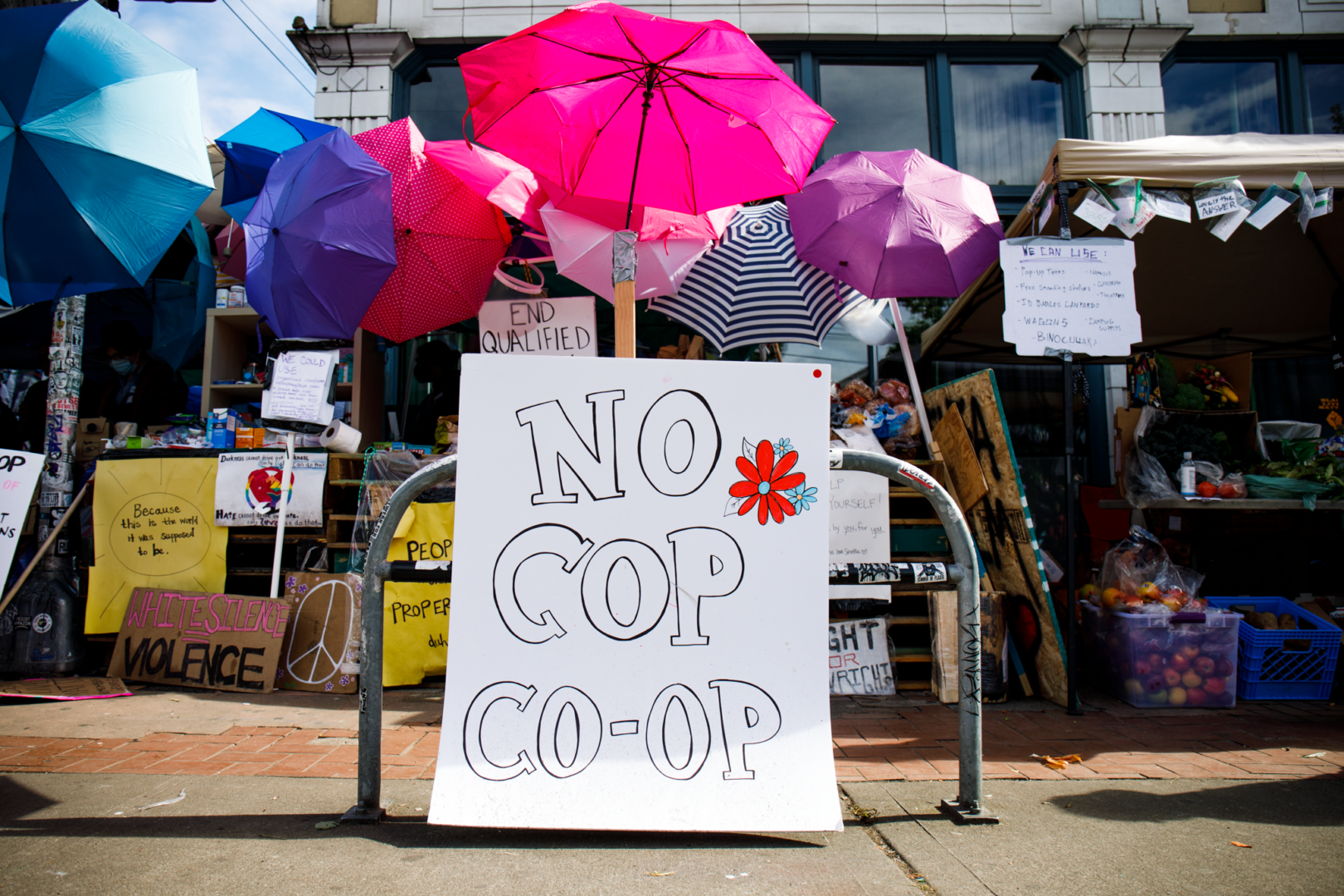
The “No-cop co-op” in the CHAZ. Photo by Derek Simeone / Flickr
Around the corner, we have a free childcare center to take some of the stress off working women of color, along with a “no questions asked” medical care facility to anyone in need. Undocumented immigrants in particular, who live outside the CHAZ, are often afraid to see a doctor because revealing their personal information could bring Immigration and Customs Enforcement (ICE) to their doorstep. CHAZ ensures that our immigrant comrades have nothing to fear when they go in for a check-up, by providing a viable alternative to Big Pharma and other western imperialist medical institutions.
Another pride and joy of the Autonomous Zone is our cooperative agricultural program. All citizens are welcome to grow and share crops in our garden area, but of course we have designated the most fertile plot of land to Indigenous peoples, so they can take ownership over what is rightfully theirs without intrusion. To those who would have never believed the people of America could break away from capitalism and say goodbye to the oligarchy: think again — the CHAZ works, and we’re expanding it with even more socially-minded programs every day.
FA: So the mutual aid group in Seattle that formed just as the pandemic hit has been very involved organizing the autonomous zone space. Setting up the food and some of the other distribution resources they used for Covid they have been able to use in this space. So that’s been really great. Then I just think the idea of mutual aid and supporting each other in the space is also a big part of this. So the “No cop co-op,” where people are just providing whatever they have and distributing it freely to people who need it. And the kind of food donations that are coming in are all part of that notion.
Some people are putting in tremendous amounts of work, way more than I am. The medical team is incredible. They have been battling the police for weeks and treating people who have been injured by the police very, very seriously. Their ability to get medical supplies and distribute them to people in need is really incredible.
What do you think about the portrayal in right-wing media? Is it really different from your own experience?
FA: The CHAZ really does feel like a festive and joyous space. There have been lots of efforts to discredit the space from the Seattle Police Department or right-wing media, even just mainstream media.
Are the police or right-wing vigilantes trying to get into the zone?
FA: The police have re-entered the space. The precinct was left completely upended. It was open, unlocked and completely accessible. In the first couple of days, no one went in. There was still that hesitancy about getting into the East Precinct. People were still unsure of what to do. And after the first couple of days the police came in and locked it and fenced it off.
From what I know, that is the only time the police have come into that space and other than that other city services are responding to the area. The mayor has directed the Fire Department, the Department of Transportation and the Parks Department to be the ones who come to that area. So I haven’t seen any police there since they came in the one time.
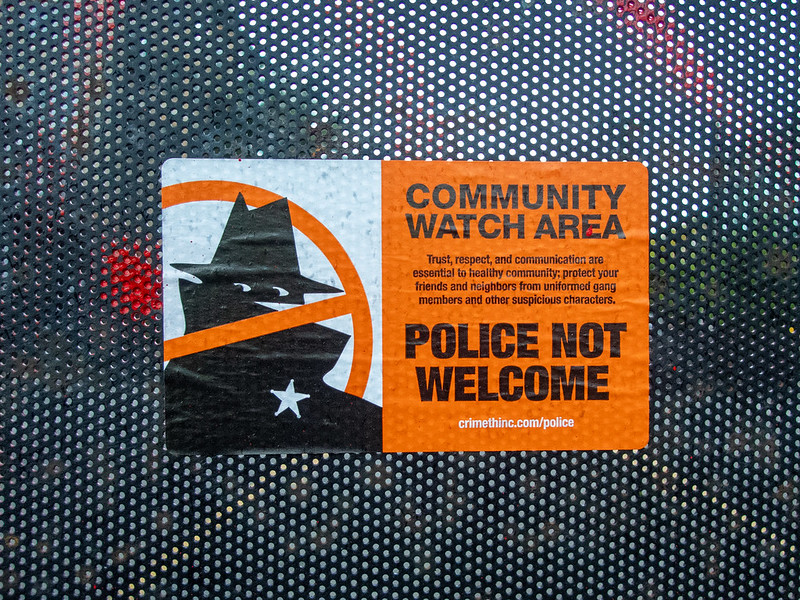
Anti-cop sticker on one of the barricades surrounding the CHAZ. Photo by Eldan Goldenberg / Flickr
OCHAZ: The fascists are always on our ass, predictable as usual. Unfortunately, it’s just something we have to expect and figure out how to deal with the best we can. The cops have left us alone for the most part, running scared ever since we exiled them from the Zone. But there is definitely a looming cloud of right-wing assholes threatening to swoop in and destroy what we’ve created here. What those assholes don’t realize, is that we are watching them like a hawk. We’ll never just lie down and take it, or let them hurt even a single hair on our people’s bodies. Sure, we’ve received threats from cops, “patriots,” biker gangs, you name it. But CHAZ has a message to all you bootlickers out there: we’ve got your number. Fuck around and find out.
How are you thinking about the CHAZ in the long term? Are you thinking of this extending into weeks and months?
OCHAZ: I’m trying my best to not get blinded by optimism. We still have a long way to go to achieve racial equity. There’s a lot of work to do to expand our reach, secure our infrastructure, and build up the kind of community that works for everybody, not just whites and white-passing POC. Those among us who come from a place of privilege are still struggling to avoid centering themselves, because dismantling the effects of racism and colorism isn’t just a one-time gig — it’s a full time job.
That’s why we are putting up daily reminders, so that the very roads we walk on will declare loud and clear what we all stand for. Little by little, we’re covering every building in sight with tributes to George Floyd, Sandra Bland, Tamir Rice, Michael Brown and others. We are de-gentrifying the city, renaming streets that were previously named after colonizers and diligently taking down any and all lingering remnants of our country’s racist past, so we can move on to a better future. We are setting our sights high, toward full self-sustainability, so that we no longer rely on donations from the outside to keep us going. The next thing on my list is to get a greenhouse going, to cultivate crops that will provide a wider range of vegan options for the kitchen.
FA: That’s a great question. When I was there yesterday, it seemed entrenched to me. People have uprooted part of the park and planted community gardens there. There’s a tent city, protesters kind of reminiscent of Occupy. All the mutual aid projects I was mentioning, the medics and the food distribution and things like that, are really well set up. The infrastructure they have is impressive. So it looks like it has staying power, to me.
What will come of that, I am unsure. There are several groups that have issued demands, some of which are aligned and some of which are a little different. We don’t know yet what they will be able to leverage from the city and what the end goal is, and I think a lot of those conversations are still emerging in the general assembly sessions that are happening and conversations in the space. But at this point it has staying power and I don’t imagine it going away anywhere anytime soon.
How have you worked with Indigenous tribes in the area?
OCHAZ: Every decision made in CHAZ comes to fruition with the full acknowledgement and understanding that this land belongs to Indigenous peoples first, full stop. Tribal needs remain a top priority in CHAZ to ensure that they get the representation they deserve, which had previously been stripped away from them by the old regime. We always take special care and consideration to work beneath local tribal leaders for approval. One of the first things we did when we established CHAZ was consult with a Duwamish Chief and his spiritual advisor. We wouldn’t dream of doing anything without their blessing.
Why are you personally so passionate about it?
FA: One, is just being concerned for Black lives, which is part of where it came from and where it started. I think where it has to end is the recognition of Black humanity, Black integrity and Black dignity. Also, at the moment we can try to rethink and radically reimagine what our cities can look like. This is one of those moments. Our budgets, at a local level, so favor militarism and violence. And that’s true at a national level too. This points to the idea that when we organize ourselves to meet human needs what emerges is beautiful constructions of art, new forms of music, new forms of literature, new political ideas, new infrastructures to provide medical care and food for each other. Those are the priorities that we should be emphasizing, and the autonomous zone states that really clearly.
OCHAZ: Simply put, Capitol Hill is my home. Our people are sick to death of being pushed around by the regime on a daily basis. I can’t sit back and watch my people be tormented by the “thin blue line” anymore. We have our own “line” up on Cap Hill: the rainbow line. And our line isn’t thin — it’s thick as fuck, and you better not cross it.
Source URL — https://roarmag.org/essays/life-and-times-at-the-capitol-hill-autonomous-zone/


